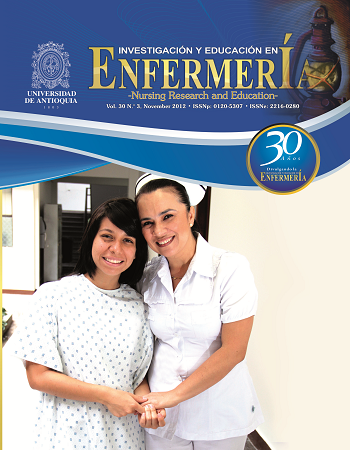Children’s health perception through creative drawing language
DOI:
https://doi.org/10.17533/udea.iee.11337Keywords:
Perception; child; health; drawings.Abstract
Objective. Children’s health perception through creative drawing language the identification of external factors perceived as negative or positive to health by children.
Methodology. A descriptive study that describes the analysis of the expressive language of drawings and written comments. The sample consisted of 130 children in 3rd and 4th classes from four randomly selected schools, in the region of Central Portugal Continental (Coimbra district). The study was conducted during the first semester of 2011. The data collection was performed by means of Rodrigues’ drawing/writing sheet. This sheet is divided in 4 areas (2 of them to draw what children consider good for health and the other 2 to write the content or message of the drawings). The themes expressed are classified based on the priority areas for the promotion of healthy lifestyles.
Results. children value healthy food, physical activity, mental health, prevention of inappropriate substance consumption and health and environment. The drawings and comments show links between diet and physical exercise, and between mental health and interpersonal relationships.
Conclusion. Drawings and comments facilitate health professionals understanding of children’s perception of health positive and negative factors. The results of the study allow planning intervention strategies in school health from infant perception.
Downloads
References
(1) Rodrigues M, Hawarylack M. O método eduterapêutico aplicado à educação para a saúde de crianças em contexto escolar. Rev Enferm Referência. 2007; 2(5):69-76.
(2) Rodrigues M. Programa de libertação criativa com imagens para crianças com necessidade de apoio pedagógico. Rev Educ. 2000; (2):75-85.
(3) Rodrigues M, Goncalez M, Fonseca M. El método eduterapeutico como estrategia de apoyo al nino hospitalizado.al nino hospitalizado. Rev Educ Deporte. 2004; 335:229-45.
(4) Menezes M, Moré CL, Cruz RM. O desenho como instrumento de medida de processos psicológicos em crianças hospitalizadas. Aval Psic. 2008; 7(2):189-98.
(5) Ring K. Young children drawing: the significance of the context. In: British Educational Research Association Annual Conference. 2001 Sept 13-15; University of Leeds, United Kingdom [Cited 2010 May 12] . Available from: http://www.leeds.ac.uk/educol/documents/00001927.htm.
(6) Albano MAS, Correia I. Lectura de cuentos infantiles como estrategia de humanizatión en el cuidado encamado en ambiente hospitalario. Invest Educ Enferm. 2011; 29(3):370-80.
(7) Brechet C, Picard D, Baldy R. Expression des emotions dans le dessin d'un homme chez l'enfant de 5 a 11 ans. Can J Exp Psychol. 2007; 61(2):142-53.
(8) Gobbi M. Desenho infantil e oralidade: instrumentos para pesquisas com crianças pequenas. In: Faria ALG, Demartini ZBF, Prado PD, Editors. Por uma cultura da infância: Metodologias de pesquisa com crianças. 2 ed. Campinas: Autores Associados; 2005. p:67-92.
(9) Natividade M R, Coutinho MC, Zanella AV. Desenho na pesquisa com crianças: análise na perspectiva histórico-cultural. Context Clinicos. 2008; 1(1):9-18.
(10) Massimo L M, Zarri D A. A Narrative Approach for Children with Cancer In Tribute to Luigi Castagnetta-Drawings. Ann N Y Acad Sci. 2006; 1089:xvi-xxiii.
(11) Kortesluoma R L, Punamaki R L, Nikkonen M. . Hospitalized children drawing their pain: the contents and cognitive and emotional characteristics of pain drawings. J Child Health Care. 2008; 12(4):284-300.
(12) Cherney I, Seiwert C, Dickey T, Flichtbeil J. Children's Drawings: A mirror to their minds. Educl Psychol. 2006; 26(1):127-42.
(13) Kostenius C, Öhrling K. (2008). Friendship is like an extra parachute': reflections on the way schoolchildren share their lived experiences of well-being through drawings. Reflective Practice. 2008; 9(1): 23-35.
(14) Imianowski S. Percepções de crianças em idade escolar sobre saúde, por meio da interpretação do desenho infantil. [Master Dissertation] . Faculdade de Saúde Pública. Departamento de Prática de languageSaúde Pública. Universidade de São Paulo, São Paulo, SP; 2001.
(15) Piko B, Bak J. Children's perceptions of health and illness: images and lay concepts in preadolescence. Health Educ Res. 2006; 21(5):643-53.
(16) Pridmore P. Visualising Health: Exploring Perceptions of children using the 'Draw-and Write Method'. Promot Educ. 1996; 3(4):11-5.
(17) Noronha I, Rodrigues, M. Saúde e bem-estar de crianças em idade escolar. Esc Anna Nery Rev de Enferm. 2011; 15(2): 95-402.
(18) Pridmore P. Children's Participation in Development for School Health. Comp Educ Rev. 2010; 30(1):103-13.
(19) Direção Geral de Saúde. Programa Nacional de Saúde Escolar. Diário da Repúblic, Despacho n.° 12.045/2006 (2.ª série); 2006.
(20) RodrigueS, M. Health magic box: an edutherapeutic technique applied to children health education. Livro de atas, 40th biennal convention. Indianapolis: STTI. 2009.
(21) Eizirik C L, Kapczinski F, Bassols, A M S. O ciclo da vida humana: uma perspectiva psicodinâmica. Porto Alegre: Artmed. 2001.
(22) Rodrigues M, Apóstolo J. Portuguese adaptation of the Child Health and Illness Profile, Child Edition (CHIP-CE). Rev Enferm Referência. 2010; 3(2):121-6.
Published
How to Cite
Issue
Section
License
Derechos de propiedad / Direitos de Propriedade
English: If the article is accepted for publication, all copyright will be of exclusive property of Investigación y Educación en Enfermería. The text and the graphics included in the publication are exclusive responsibility of the authors and not necessarily reflect the thought of the Editorial Committee.
Español: Si el artículo es aprobado para publicación, todos los derechos son de propiedad de Investigación y Educación en Enfermería. El texto y las gráficas incluidas en la publicación son de exclusiva responsabilidad de los autores y no necesariamente refleja el pensamiento del Comité Editorial.
Português: Se o artigo for aceito para publicação, todos os direitos autorais serão de propriedade exclusiva de Investigación y Educación en Enfermería. O texto e os gráficos incluídos na publicação são de responsabilidade exclusiva dos autores e não refletem necessariamente o pensamento do Comitê Editorial.















